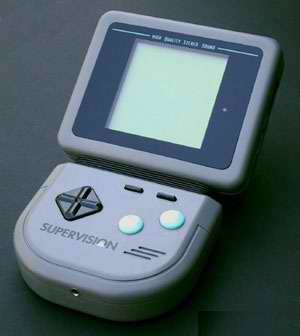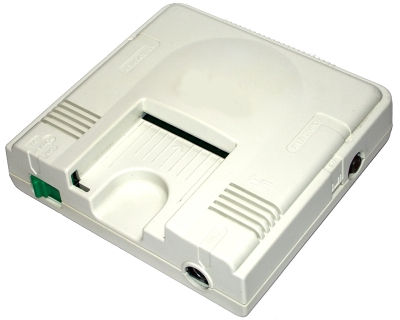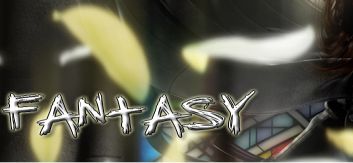console a 32 bit, periodo storico fmetà anni novanta, per molti di questi sistemi è possibile scaricare (download rom) le rom o le iso*
Sega Master System
Da Wikipedia, l'enciclopedia libera.
Il Sega Master System (comunemente Master System), è una consolle per videogiochi a 8 bit basata su cartucce prodotta da SEGA. É la versione internazionale della consolle giapponese SG-1000 Mark III. La consolle rese la SEGA il principale competitore della Nintendo nel mercato giapponese e mondiale. Il Master System venne lanciato in diretta concorrenza del Nintendo Entertainment System. La consolle non è riuscita a spodestare il competitore ma comunque ha goduto di un buon successo commerciale che si è protratto in mercati secondari come quello del Brasile.
Ricavato da "http://it.wikipedia.org/wiki/Sega_Master_System"
|
History
The SG-1000 Mark III came after the SG-1000 Mark I and SG-1000 Mark II. It was released in Japan on October 20, 1985. The mascot of the system was Alex Kidd.
The system was redesigned and was sold in the United States under the name Sega Master System in June 1986, one year after the Nintendo Entertainment System was released. The console sold for $200. The Master System was then released in other places, including a second release in Japan in 1987 under its new name.
Though the Master System was more technically advanced in most ways than the NES, it did not attain the same level of popularity among consumers in the United States. Its lack of success in the U.S. has been attributed to various causes, among them the difference in game titles available for each platform and the slightly later release date of the Master System. The licensing agreement that Nintendo had with its third-party game developers had a profound impact. The agreement stated, in effect, that developers would exclusively produce games for the NES. The Master System sold 125,000 consoles in the first four months. In the same period, the NES would net 2,000,000.
Nintendo had 90% of the North American market at the time. Hayao Nakayama, then CEO of Sega, decided not to use too much effort to market the console in the NES-dominated market. In 1988, the rights to the Master System in North America were sold to Tonka, but its popularity continued to decline. The move was considered a very bad one, since Tonka had never marketed a video game system and had no idea what to do with it.
Sega Master System IIIn 1990, Sega was having success with its Sega Mega Drive/Sega Genesis and as a result took back the rights from Tonka for the SMS. They designed the Sega Master System II, a newer console which was smaller and sleeker but which, to keep production costs low, lacked the reset button and card slot of the original. In an effort to counter Nintendo's Super Mario Brothers the new system would include a built-in Alex Kidd in Miracle World, or later Sonic the Hedgehog, playable without any cartridges. Sega did everything in its power to market the system, but nothing came out of it.
By 1992, the Master System's sales were virtually nonexistent in North America and production ceased. Sales were poor in Japan as well, due to the dominance of the main competitor from Nintendo, the Nintendo Family Computer (Famicom).
In Europe, Sega marketed the Master System in many countries, including several in which Nintendo did not sell its consoles. It had some success in Germany, where it was distributed by "ariolasoft" since Winter 1987. The Europeans had garnered lots of third party support for the SMS and as a result, it was able to outsell the NES in Europe. Nintendo was forced to get licensing for some popular SMS titles in that market. The Master System was supported until 1996 in Europe. It was discontinued so that Sega could concentrate on the new Sega Saturn console. Sales of the SMS in Australia were not as strong as the NES enjoyed there, however the SMS was able to gain greater market share than it had in North America[citation needed].
Brazil was one of the SMS' most successful markets. It was marketed in that country by Tec Toy, Sega's Brazilian distributor. A Sega Master System III (and even a semi-portable SMS VI) had been released in that market and several games had been translated into Portuguese. The characters in the said games had been modified so that they appealed to Brazilian mainstream audiences (for example, Wonder Boy in Monster Land featured Mônica, the main character from a popular children's comic book in Brazil, created by Maurício de Sousa). Brazil also produced 100% national titles, like Sítio do Pica Pau Amarelo (based on Monteiro Lobato workmanship) and Castelo Ra-Tim-Bum (from TV Cultura series). Brazil was also where the first several Sonic the Hedgehog Game Gear titles started out. Tails, one of the characters, made his worldwide debut in Sonic the Hedgehog 2 for the Master System. That title would later be ported to the Game Gear in other markets.
Master System Compact: wireless variant developed in Brazil.The most notable Master System step in Brazil was the compact 100% wireless system and developed by Tec Toy. The console transmit the A/V signal in radio frequency, dispensing cable connections. It was produced from 1994 to 1997 and is still a target for console collectors.
Later in its life in Brazil, Game Gear games had been ported to the Master System and several original Brazilian titles were made for the system. Tec Toy also produced a licensed version of the wildly popular fighting game Street Fighter II for the Master System. Despite the limitations of the console, the game turned out to be fairly well received. The console production was familiar to the Brazilians, which explains the success in that market. During the Master System's final days in Brazil, games had been marketed for small children.
The Sega Master System is still being produced in Brazil. The latest version is the "Master System III Collection". It uses the same design as the North American Master System II (Master System III in Brazil), but is white and comes in two versions: one with 74 games built-in and another with 105 games built-in on an internal ROM. However, in Brazil it is hard to find the 3D Glasses, the Light Phaser and even cartridges, leaving most Brazilians with only built-in games.
Overall, the SMS was mildly successful worldwide, but failed to capture the Japanese and North American markets. Sega learned from its mistakes and made the succeeding Sega Mega Drive/Sega Genesis wildly popular in Europe, Brazil, and North America.
Media input
One of the most unique features of the Sega Master System was its dual media inputs: one cartridge slot and one card slot. The card slot accepted small cards about the size of a credit card. Most cards were games, but one card served an entirely different purpose. The 3D glasses plugged into the console via the card slot, and allowed 3D-looking visual effects for specially designed cartridge games. In this fashion, both media inputs worked in tandem to create a more enthralling experience.
Game controllers
Sega Master System ControllersSega Master System game controller was considered extremely durable. However, there were only 2 buttons, one of which additionally performed the function of the traditional "Start" button; The pause button was on the game console itself. The original controllers, like Sega's previous systems, had the cord emerging from the side; at some later point they changed to the now-typical top emerging cord. When the game Street Fighter II was released (in Brazil only), a new six-button model similar to the Sega Genesis controller was also released. The current Brazilian Master System consoles come with two of those six-button controllers.
changed to the now-typical top emerging cord. When the game Street Fighter II was released (in Brazil only), a new six-button model similar to the Sega Genesis controller was also released. The current Brazilian Master System consoles come with two of those six-button controllers.
Sega Master System Light Phaser is a light gun modeled after the Zillion gun from the Japanese anime series of the same name. The design also mirror the 1980s trend of actual laser tag gun appearances.
Sega Master System 3D GlassesSega Scope 3D glasses used a shutter system to close the left and right lens rapidly to create a 3D effect. Some NES games, like Rad Racer, claimed to be 3D, but were actually duplicating the experience with much cheaper red-cyan 3D glasses. The Master System glasses can only be used in the Master System I since it hooks up directly to the card port not found in the Master System II. Another attempt at this would not be seen until a decade later, in 1995, when Nintendo reattempted the 3D concept with the Nintendo Virtual Boy. Only a small handful of games for the SMS were 3D compatible.
Hang-On
Sega (1985)
Alex Kidd in Miracle World
Sega (1986)
After Burner
Sega (1987)
Phantasy Star
Sega (1987)
Wonder Boy in Monster Land
Sega (1988)
*Populous
TecMagik (1991)
Sonic the Hedgehog
Sega (1991)
*Marble Madness
Tengen (1992)
* Not released in the U.S
Specifications
Game cartridges for Japanese SG-1000 Mark III (left), US/European Sega Master System (right).CPU: 8-bit Zilog Z80
3,546,893Hz for PAL/SECAM, 3,579,545Hz for NTSC
Graphics: VDP (Video Display Processor) derived from Texas Instruments TMS9918
Up to 32 simultaneous colors available (16 for sprites, 16 for background) from a palette of 64 (can also show 64 simultaneous colors using programming tricks)
Screen resolutions 256x192 and 256x224. PAL/SECAM also supports 256x240
8x8 pixel characters, max 488 (due to VRAM space limitation)
8x8 or 8x16 pixel sprites, max 64
Horizontal, diagonal, vertical, and partial screen scrolling
Sound (PSG): Texas Instruments SN76489
4 channel mono sound
3 sound generators, 4 octaves each, 1 white noise generator
Sound (FM): Yamaha YM2413
9 channel mono FM sound
built into Japanese Master System
available as plug-in module for Mark III
supported by certain games only
ROM: 64 kbit (8 kB) to 2048 kbit (256 kB), depending on built-in game
Main RAM: 64 kbit (8 kB)
Video RAM: 128 kbit (16 kB)
Game Card slot (Mark III and Master System 1 only)
Game Cartridge slot
Japanese and South Korean consoles use 44-pin cartridges, same shape as Mark I and Mark II
All other consoles use 50-pin cartridges with a different shape
The difference in cartridge style is a form of regional lockout
Expansion slot
Notable games
After Burner
Alex Kidd in Miracle World - Integrated into one version of the console
Alex Kidd in Shinobi World
*Asterix
Astro Warrior - Along with Hang-On, integrated into one version of the console (the Sega Base System, which was slightly less expensive and lacked the Light Phaser).
California Games
Choplifter
Double Dragon
*Ecco the Dolphin
*Ecco the Dolphin: The Tides of Time
Ghouls 'n Ghosts
Golden Axe Warrior
Hang-On - Integrated into one version of the console
The Jungle Book (video game)
Kenseiden (剣聖伝)
*Master of Darkness
*Ninja Gaiden
Out Run (アウトラン)
Phantasy Star (ファンタシースター)
Psycho Fox
Rampage
Safari Hunt - Integrated into one version of the console
Shinobi (忍)
Snail Maze - A simple maze game that was included on the system BIOS. It was accessed by pressing and holding Up and buttons 1 and 2 after turning on the system without a game loaded.
Sonic the Hedgehog - Integrated into one version of the console. This was the last Master System title released in the US.
*Sonic the Hedgehog 2
*Sonic the Hedgehog Chaos
Space Harrier
Teddy Boy
Thunder Blade
Wonder Boy
Wonder Boy in Monster Land
*Wonder Boy in Monster World
Wonder Boy III: The Dragon's Trap
*World Cup Italia '90 - First World Cup franchise.
Ys: The Vanished Omens - credited with introducing many players to the Ys series.
See also List of Sega Master System games
* Not released in the U.S
|
* le rom possono essere scaricate da altri siti web o sfruttando le risorse della rete, chi scarica deve averne il diritto legale.
PC Engine
|
Da Wikipedia, l'enciclopedia libera.
Il PC Engine è una consolle prodotta dalla NEC e presentata sul mercato Giapponese nel 1987.
Il PC Engine è un progetto collaborativo tra la società di software Giapponese Hudson Soft (che ha anche una divisione dedicata all'hardware) e la NEC. La collaborazione nacque perché la Hudson stava cercando una grande società con cui dividere gli elevati costi di sviluppo, produzione e marketing di una nuova console mentre la NEC stava cercando un partner per entrare nel lucroso mondo dei giochi elettronici. Il PC Engine è una consolle molto piccola, questo è dovuto all'utilizzo di un'efficiente architettura basata su tre chip e all'utilizzo di cartucce dalle ridotte dimensione apparteneti allo standard HuCard. Il processore 65C02 della MOS Technology è coadiuvato da un chip grafico a 16 bit e da un chip specializzato di codifica video. Entrambi i chip erano progettati dalla Hudson.
Ricavato da "http://it.wikipedia.org/wiki/PC_Engine"
STORIA
Il PC-Engine nacque nell'ormai lontano 1987, frutto dell'ideazione di uno staff tecnico che operava presso i laboratori della NEC of Japan e della Hudson Soft.
Il primo nato della famiglia PC-Engine, venne chiamato COREGRAFX. Questa piccola e bianca console utilizzava come processore principale un 8bit, per esattezza un 65C02 con un clock a 7,2Mhz, coaudiovato da due coprocessori a 16bit capaci di gestire la maggior mole di lavoro a livello grafico.
Al momento della sua uscita, il COREGRAFX si rivelò la più potente console disponibile sul florido mercato del Sol Levante ed ebbe subito un grandissimo successo; i suoi primi rivali, ovvero Sega Master System e Nintendo Famicon (conosciuto da noi come NES), si dovettero ben presto inchinare alla supremazia della macchina targata NEC, la quale poteva proporre fedelissime conversioni degli arcade più in voga del momento (ricordiamo, tra i tanti, R-Type, Ninja Spirit e Splatterhouse).
Dal punto di vista tecnico, il COREGRAFX poteva visualizzare 512 colori contemporaneamente su schermo e gestire una risoluzione di 256x216 pixels, la quale era sufficente per poter generare entusiasmanti videogiochi. Le capacità sonore erano più che adeguate, con 6 voci stereo su 8 ottave, di cui una FM.
I giochi venivano memorizzati sulle mitiche Hu-Card (delle cartucce grandi quanto una scheda telefonica e di una capacità che variava tra i 2 e i 20 Mbit), ed era disponibile anche un lettore CD-Rom, il primo in assoluto per una console, il quale venne subito supportato da una vastissima softeca.
Poca fortuna ebbe invece il secondo nato di casa NEC, il SUPERGRAFX, concepito come un Super PC-Engine dal design super accattivante, il quale si distingueva per le sue prestazioni eccezionali, in grado di poter reggere ampiamente il confronto con quelle del Super Famicom e di surclassare quelle del Megadrive, ma anche per una ludoteca alquanto povera, sebbene di ottima qualità (ricordiamo titoli indimenticabili come 1941, Aldynes e Ghouls'n Ghosts).
Su questa macchina, che era totalmente compatibile verso "il basso", si trovava la stessa CPU del COREGRAFX, i suoi coprocessori ma anche 4 chip custom in più. Questi garantivano 128 sprite visualizzabili contemporaneamente su shermo, una risoluzione di 320x244 ed una palette di 4096 colori.
Il PC-Engine si diffuse tantissimo in Giappone, ma nel resto del mondo in pochi compresero la sua vera essenza, il divertimento che i suoi giochi riuscivano a trasmettere, la particolarità del suo design e dei suoi bellissimi titoli; il COREGRAFX era praticamente un must per gli amanti degli shoot'em up.
Tra i migliori games disponibili per questa mitica console ricordiamo: PC Kid I, II e III, i fantastici spara-spara quali Gunhed, Gates of Thunder, Nexar, Spriggan ed i migliori titoli (quasi tutti su CD-Rom) ispirati ai fumetti manga nipponici, come Conan, Ranma 1/2, Lamù e la saga di Valis.
Il lettore CD-Rom, il primo in assoluto per una console, venne commercializzato in Giappone nel 1989.
Nella foto a sinistra possiamo vedere come si presentava quando era inserito nella sua docking station, assieme al PC-Engine.
Questo tipo di supporto presentava, e presenta ancora oggi, due principali vantaggi: per i giocatori, permette di immagazinare su ogni cd circa 650Mb di dati, e questo significa animazioni migliori, grafica più dettagliata e colorata, delle musiche di qualità cd ecc.
Per le software house, invece, il CD-Rom è molto meno caro da produrre di una cartuccia, anche se i costi ed i tempi di sviluppo sono generalmente più elevati...).
Il lettore CD-Rom della NEC si connetteva direttamente alle consoles Coregrafx I, II e Supergrafx ed era in grado di leggere, oltre ai titoli su CD-Rom, i normali CD audio ed i CD+G.
Una volta richiuso nella sua scatola, il lettore diventava una comoda e trasportabilissima valigetta.
Da notare, inoltre, che l'unità CD-Rom poteva essere estratta dalla docking station, diventando così, con l'aggiunta di un particolare battery pack, un normale lettore di CD portatile.
Il lettore veniva utilizzato assieme ad una speciale HuCard che ne conteneva il sistema operativo: la CD-Rom System Card.
Dopo circa un anno dall'uscita del lettore venne rilasciata la Super CD-Rom System Card, la quale poteva vantare 2Mb di memoria video (contro 1Mb della versione precedente) e che venne upgradata nelle versioni 2.0, 2.1 e 3.0.
Nel 1994 la NEC lanciò l'Arcade Card (di cui vediamo il logo, assieme a quello dei titoli del Super CD-Rom, nelle immagini qui a fianco), che espandeva a 16Mb la memoria video del PC-Engine Duo.
Questo permise alcune fedelissime conversioni di titoli del Neo-Geo, tra cui World Heroes 2, Art of Fighting, Fatal Fury 2, Fatal Fury Special e la realizzazione di alcuni capolavori come Strider (inizialmente previsto per il Supergrafx) e l'indimenticabile Sapphire, forse il miglior spara e fuggi mai realizzato su console, il quale venne prodotto in un numero limitato di copie e quindi diventò ben presto un oggetto da collezione (pensate che oggi è valutato intorno ai 500$).
TurboGrafx 16
|
Da Wikipedia, l'enciclopedia libera.Il TurboGrafx 16 è una consolle a 8 bit prodotta dalla NEC e presentata nel 1989 nel Nord America. Questa è la versione Nord Americana della consolle PC Engine. Un numero molto ridotto di consolle venne venduto anche nel Regno Unito nel 1990 con il nome di TurboGrafx (senza il 16 finale). Un numero ridotto di consolle compatibili con lo standard PAL vennero vendute in Europa.
Il TurboGrafx-16 è un sistema a 8 bit con dei chip grafici a 16 bit (dai quali deriva il 16 finale nel nome) in grado di visualizzare fino a 512 colori sullo schermo contemporaneamente. La consolle utilizzava come supporto di memorizzazione le cartucce Hucard, delle cartucce molto sottili e piccole sviluppate dalla Hudson (HuCard = Hudson + Card), il co sviluppatore della consolle. Le cartucce avevano la dimensione di una carta di credito più spessa. Come dimensione assomigliavano alle cartucce utilizzate dal Sega Master System per alcune tipologie di giochi ma a differenza di questo il TurboGrafx 16 accettava escusivamente questa tipologia di cartucce.
Ricavato da "http://it.wikipedia.org/wiki/TurboGrafx_16"
La prima foto qui a fianco ritrae la confezione di una piccola console all-in-one (tutto in uno), una vera e propria dream machine!
uno), una vera e propria dream machine!
Il suo nome è PC-Engine LapTop (abbreviato LT) e consiste in un normale PC-Engine al quale sono stati aggiunti, all'interno di un unico chassis, un controller ed uno schermo LCD da 8" a matrice attiva di altissima qualità. 
Inutile dire che l'LT era perfettamente compatibile con tutta la softeca del PC-Engine ed inoltre questa piccola meraviglia poteva essere connessa al lettore CD-Rom, rendendo quest'ultimo una potentissima stazione da gioco portatile.
Una volta chiuso, il LapTop era grande quanto un lettore di CD portatile; l'unico neo: il prezzo, circa 800$.
Il PC-Engine Shuttle rappresentava una versione economica del Coregrafx.
Dotato di uno chassis decisamente accattivante (a cui si ispirarono sicuramente all'Atari per il Jaguar), non disponeva della presa di connessione al lettore CD-Rom ed era venduto ad un prezzo decisamente appetibile.
Non riscosse un grande successo, ed a causa delle poche unità prodotte e vendute è diventato anch'esso un prezioso e super valutato oggetto da collezione per tutti i fans del PC-Engine.
Il Duo-R ha rappresentato il penultimo modello di PC-Engine lanciato dalla NEC.
Consisteva in un Duo (cioè Coregrafx + lettore CD-Rom) di colore bianco e privo della presa jack per le cuffie, dotato di un lettore cd molto piu' stabile.
In seguito venne commercializzato il Duo-Rx (che potete ammirare nella foto qui a destra), del tutto simile al suo predecessore, dal quale differiva unicamente per il joypad a 6 tasti (utilissimo per i picchiaduro che vennero convertiti dal Neo-Geo) e per l'Arcade Card che venivano venduti in bundle con la console.
Watara Supervision
Da Wikipedia, l'enciclopedia libera.
Il Watara Supervision è una consolle portatile non a colori presentata nel 1992 e era un'alternativa a basso costo della consolle Game Boy. Insieme alla consolle era incluso un gioco chiamato Crystball.
La consolle era dotata di un ampio schermo (da cui il nome) e di grandi pulsanti, nonostante questo la qualità costruttiva non era delle più eccelse. I giochi non erano di alta qualità e quindi la macchina non è stato un grande successo commerciale. La forma esterna della consolle ha subito molte modifiche con trascorrere degli anni e l'ultimo modello è stato venduto fino al 1996.
Il Supervision è stato anche venduto da molte aziende nel mondo con altri nomi, tra i quali Quickshot Supervision e Hartung SV-100.
Ricavato da "http://it.wikipedia.org/wiki/Watara_Supervision"
|
Processore: M64C02 4.00MHz 8-bit VLSI;
|
|
Da Wikipedia, l'enciclopedia libera.
Il PC-FX è una consolle a 32 bit prodotta dalla NEC e successore del PC Engine. La macchina venne presentata in Giappone il 23 dicembre 1994. Il PC-FX utilizza esclusivamente CD-ROM a differenza del PC Engine che utilizzava le cartucce HuCard (se non era installato il lettore di CD). Inusualmente la consolle ha una forma simile a quella di un computer nello specifico un computer in un case Tower mentre in quel periodo la maggior parte delle consolle concorrenti erano inserite in case piatti in modo da poter essere agevolmente posizionate vicino agli altri elettrodomestici. Il controller era un joypad simile a quello utilizzato dal Sega Mega Drive ma con molti più pulsanti. Un'altra caratteristica interessante erano le tre porte di espansione della macchina. Le porte di espansione in questo genere di macchine sono abbastanza inusuali dato che, la loro inclusione ha un costo ma la maggior parte degli utilizzatori non ha necessita di espandere le potenzialità delle consolle e quindi in sostanza si innalza il costo della consolle senza fornire un servizio migliore all'utente.
Ricavato da "http://it.wikipedia.org/wiki/PC-FX"
|
|
|||||
|
|
|||||
|
|
























